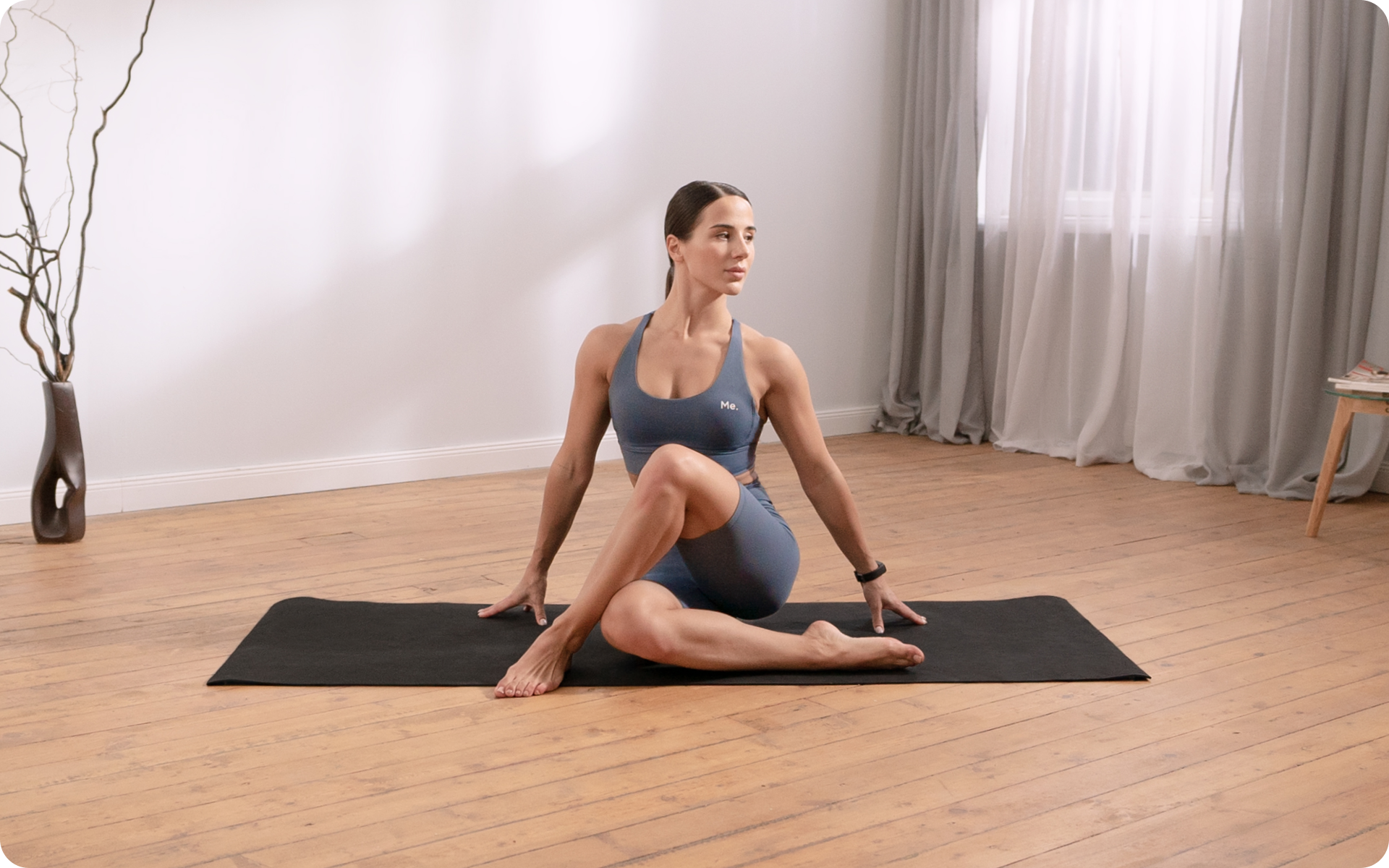For most people who are looking to get into fitness, a 7-day workout plan often seems like the best game plan. After all, the more you work out, the faster the results, right? But, have you perhaps considered that a 3-days-a-week workout plan could be a better or rather an easy but effective option to help you achieve your fitness goals?
Whether you’re looking to have a flatter midsection, leaner thighs, a more shapely butt or just fit into that pair of jeans that fit you a year ago, you don’t have to work out seven or even five days a week to achieve these goals. Sometimes less is more.
Read on to find out more about working out 3 days a week benefits, how to make a proper routine, estimated weight loss results, and more.
What Is the Best 3-Days-a-Week Workout Plan?
If you’re wondering ‘how should you do a 3-days-a-week workout?’, the best thing to do is look for or make an exercise routine that suits your needs and experience levels (beginner, intermediate, expert), exercises your entire body, and gives you ample time to rest, recover, and build your muscles.
For example;
If working out 3 days a week weight loss is your main goal, then a routine that incorporates both cardio and strength training will be best. If you’re fit and aiming for muscle growth, then a routine with slightly less cardio and more heavy weight training sessions will be better.
The options are endless. Make sure to understand what you want first so you can fine-tune your routine for the best results.
BetterMe is your fast-track ticket to a long-lasting weight loss! Tailor your fitness journey and maximize your results with just a couple of swipes!
What Are the Benefits of a 3-Days-a-Week Full Body Workout?
Working out 3 days a week for 1 hour or just 30 minutes has the following potential benefits:
- Saves on time. The average working adult must make time for work obligations, socializing, family obligations, and hobbies, all in a mere 24 hours each day. It can all be quite overwhelming, even before you add going to the gym to the mix.
By choosing to work out 3 days a week, you get more leeway to fit everything you need to do in a day or week perfectly into your schedule. Opting to do full-body workouts instead of a split routine allows you to work all muscle groups, thereby cutting down the time you spend in the gym.
- Increased rest times. For muscle to grow, you need to give it enough time to recover. The recommended rest time in a week for optimal muscle growth is 1 to 2 days (6). Doing full-body workouts three times a week gives you more than enough time to let your muscles rest and grow.
Pro tip: Use one or two of your four rest days to engage in some active rest activities. These activities are basically low-intensity exercises such as walking, yoga, and swimming. According to Healthline, moving your body with such exercises helps reduce soreness, keeps the muscles flexible, reduces lactic acid buildup in muscles, and boosts blood circulation throughout the body (13).
- Weight loss. For someone who is looking to lose fat, full-body workouts work better than isolation exercises. They burn more calories, particularly if your full-body workouts are high-intensity exercises such as HIIT, Tabata, running, or dancing.
- Better health. Working out, particularly using cardio exercises, has been linked to a reduced risk of chronic illnesses, improved mental health, and better sleep patterns (1). Not only does exercising help prevent illnesses, it could also help improve existing conditions – just make sure to speak to your doctor before you undertake any new workout activity to prevent worsening an existing condition.
- It is flexible. While you can choose the specific days of the week when you want to work out, a 3-days-a-week workout plan gives you ample time to recover from any missed workouts. This makes it the perfect option for busy office workers, small business owners, new mothers who are looking to keep fit, and students with packed class schedules.
- Less chance of boredom. The problem with isolation workouts is that they are more or less set, such as with bicep curls are bicep curls where you use weights. However, full-body workouts allow for more variety. This reduces your chances of abandoning your routine and giving up on your goals.
- Work best for home workouts. Unlike isolation workouts that require gym weights or machines, there are many full-body workouts that don’t. They can be done easily using just your body weight and improvised weights for the extra challenge.
- Can be done anywhere. In the gym, at home, at work (e.g. climbing stairs), while running errands (i.e walking or running). Full-body exercises are extremely convenient.
- Increased muscle mass and strength. If you were to look up the best exercise routine for muscle growth, you would most likely see multiple sources advising you to work out up to 6 times a week for the best results.
While there is some truth in this, research has shown that you can work out for fewer days and still achieve the same result. According to a study published in the Journal of Strength and Conditioning Research in 2018, training volume matters more than training frequency.
In this study, researchers took 28 young, healthy resistance-trained men and divided them into two groups. The first group worked out three days a week, while the other exercised six days a week.
All participants performed the same strength training exercises, including bench presses, squats, and deadlifts, focusing on their one rep max. They also all trained in the same volume and frequencies.
At the end of the study, researchers found that while working out more (6 times a week) increased strength and fat-free mass in participants, it did not lead to increased strength. Those who worked out 3 times a week had the same strength and hypertrophy levels as those who worked out for more days (11).
Read more: Is a 7 Day Workout Plan The Best Choice For You?
How to Work Out 2 Times a Day 3 Days a Week
While most people prefer to workout just once a day and be done with it, some people like to challenge themselves and their bodies by exercising twice a day. If you’re in the latter group and are unsure how to incorporate two exercise sessions into a 3-days-a-week workout plan, here are some tips to help you:
Do your more challenging workouts in the morning
Can you imagine thinking about doing CrossFit or a HIIT class after a busy and grueling day at work? Chances are you’ll simply skip your workout and go home or not give your all in the session.
To avoid this, schedule your most intense exercises for the morning hours. In this way, your later session is easier to do no matter how hard your day is.
Schedule the sessions several hours apart
If you’re going to be exercising twice a day, you need to give yourself enough time between the workouts. This time will allow you to eat, refuel your muscles, and rest, giving your body and muscles time to recover and re-energize. Don’t be tempted to do two workout sessions back to back.
Drink your water
Set a reminder for this if you have to. Hydration is important whether you’re exercising or not. However, if you’re going to have a 2-times-a-day, 3-times-a-week workout routine, then hydration before, during, and after a session is especially important.
Water helps regulate your body temperature and lubricate your joints – non-lubricated joints can lead to injury. It also helps transport nutrients throughout the body to keep you healthy and energized. This same energy from nutrients is what you’ll need for your body to be strong enough to keep up with your routine.
Try skipping a day in between your workout days
While it can be tempting to schedule your workouts back to back so you can get them out of the way, this is not a good idea. Instead, we suggest that you skip at least one day before you have to be at the gym again.
Remember that it takes a minimum of 24 hours for your muscles to recover after a relatively light workout and up to three days after a more intense session.
Even if you’re doing a 3-days-a-week workout for mass, muscle will only grow after it has been given time to repair the tears that occurred while exercising – this does not happen overnight and it can take anywhere from one day to several days for them to grow bigger and stronger than before.
Watch out for any signs of overtraining
While working out twice a day, 3 days a week certainly has its benefits, it’s not suitable for everyone.
If you notice your performance at the gym has decreased, your muscles are no longer growing, you’ve lost your appetite and no longer sleep well, or you’re getting ill more often, you could be overdoing it and it’s time to reduce how much you work out.
It’s better to prevent this than to look for ways to recover from overtraining.
Keep an eye on the clock
As mentioned above, working out twice a day is quite a feat. You should limit your workout sessions to between 30 and 45 minutes. This will allow you to work out for a combined 60 to 90 minutes a day. Doing this also goes a long way to preventing the aforementioned overtraining.
BetterMe app will provide you with a host of fat-frying fitness routines that’ll scare the extra pounds away and turn your body into a masterpiece! Get your life moving in the right direction with BetterMe!
How Many Sets For a 3-Days -a-Week Full Body Workout?
The debate concerning how many sets you need to do for maximum gains is an ongoing one in the fitness community. Some people believe that the more sets you do, the more your chances of working all the muscle fibers in a given muscle group and the better the results. However, other people believe that fewer sets will still help you achieve your desired results.
So who is right and who is wrong?
Well, both sides are correct to a point – it is all dependent on what your goals are. For example, a person who is doing a 3-days-a-week workout for mass and not strength will benefit from more reps.
This was proven in a study that was published in the Medicine & Science in Sports & Exercise journal in 2018. In this study, 34 men were divided into three groups and they all had to work out three times a week for eight weeks. The first group only did one set per exercise per training session, while the second did 3 sets, and the last group did 5 sets per training session.
At the end of the eight-week study, the third group had the biggest gains in terms of muscle mass (9).
So what is the consensus? How many sets for a 3-days-a-week full body workout?
If you’re not concerned much about mass, strength, and endurance, MensHealth suggests that doing three sets or less of 8 to 12 reps per muscle group is safe and enough to see results. If you want to do more sets, then do up to five sets but keep your reps to six or fewer(15).
If you have specific goals and want to know how many sets will work best for you to see results, you should try the following:
- For increased muscle mass. Do 3 to 4 sets with 6 to 12 reps per set.
- For endurance. Do 2 to 3 sets with 12-20 reps per set.
- For muscle strength. 3 to 5 sets with 2 to 6 reps per set are enough.
- For general fitness. 2 to 3 sets with 8 to 12 reps will help you get more fit.
Rest periods and intensity of each workout also matter, but for the most part, this is what your reps and sets should look like.
How to Design a 3-Days-a-Week Dumbbell Workout
If you don’t want to go to the gym and the only weights you have on hand are dumbbells, here is a simple 3-days-a-week dumbbell workout plan you can follow to ensure you exercise your whole body:
Day 1 – Full Body Pull Workout
- Warm-up – Do a few quick stretches and 10 to 15 minutes of cardio
- Dumbbell pullovers – 3 sets of 8 to 12 reps
- Dumbbell reverse fly – 3 sets of 8 to 12 reps
- Bicep curls – 3 sets of 8 to 12 reps
- Dumbbell bent over row – 3 sets of 8 to 12 reps
- Dumbbell Romanian deadlift – 3 sets of 8 to 12 reps
- Dumbbell hip thrust – 3 sets of 8 to 12 reps
- Dumbbell calf raises – 3 sets of 8 to 12 reps
Day 2 – Rest Day
Day 3 – Full Body Push Workout
- Warm-up – Do a few quick stretches and 10 to 15 minutes of cardio
- Walking dumbbell lunges – 3 sets of 16-20 reps (8-10 per leg)
- Dumbbell squats – 3 sets of 8 to 12 reps
- Dumbbell shoulder press – 3 sets of 8 to 12 sets
- Dumbbell step ups – 3 sets of 8 to 10 reps per leg
- Dumbbell chest press – 3 sets of 8 to 12 reps
- Dumbbell lateral raises – 3 sets of 8 to 12 reps
- Dumbbell chest fly – 3 sets of 8 to 12 reps
Day 4 – Rest Day
Day 5 – Full Body Workout
- Warm-up – Do a few quick stretches and 10 to 15 minutes of cardio
- Dumbbell squat to shoulder press – 3 sets of 8 to 12 reps
- Standard pushups – 8 to 12 reps
- Dumbbell single-leg RDL – 3 sets of 8 to 12 reps per leg
- Dumbbell single arm row – 3 sets of 8 to 12 reps per arm
- Dumbbell overhead tricep extension – 3 sets of 8 to 12 reps
Remember to do your warm-up and cool-down before and after your workout.
How Should You Do a 3-Days-a-Week Workout?
There is no set way to make a 3-days-a-week workout plan. Any workout plan you choose to do should be one that suits your lifestyle and meets your goals.
That being said, here are the things you should consider when determining what could work best for you:
- On what days do you like to exercise? Do you prefer to work out on three consecutive days or skip a day in between? Are weekends okay for you or would you prefer to keep your weekends open for something else? Three simple 3-days-a-week workout routines to choose from include:
Example 1 – Monday, Wednesday, and Friday
Example 2 – Monday, Tuesday, and Wednesday
Example 3 – Wednesday, Friday, and Saturday
- Home workouts or going to the gym? Some routines are curated for people who often work out at the gym, while others work best for home workouts as they don’t require any equipment or machines.
- What are your goals? Are you looking to gain more muscle and bulk up, look more shredded, or do you just want to shed some extra pounds. Find a routine that is aligned with your goals.
If you’re a beginner who’s looking to shed some weight, there’s no point in trying to match your workout plan to a bodybuilder as it will not align with your goals.
Read more: A Postpartum Workout Plan for Every Mom: Your Guide to Fitness After Baby
FAQs
Is 3 days a week enough for a workout?
Yes, it is. As seen above, working out for just 3 days a week has multiple health benefits, including helping you reach and maintain a healthy weight.
Is it better to work out 3 or 4 days a week?
We have proven that physical activity three times a week is good for you. However, if your strength and schedule allows, exercising 4 days a week may be better. When it comes to keeping fit, physical activity three times a week is considered the bare minimum (12, 5).
According to the Centers for Disease Control and Prevention, a good 4-day workout routine could include either (7, 12):
- Vigorous aerobic activity such as jogging or running for 75 minutes twice a week plus strength training that works all major muscle groups twice a week.
- An equivalent mix of moderate and vigorous-intensity aerobic activity 2 days a week and work all major muscle groups 2 days a week.
Either option is ideal for someone who’s looking to lose weight and also build muscle. For those who are interested in building muscle mass and strength, a 4-day workout split could also work. A 4-day split workout routine could look like:
- Day 1 – Lower body quad-focused exercises
- Day 2 – Upper body push-focused exercises
- Day 3 – Rest
- Day – Lower body hamstring-focused exercises
- Day 5 – Upper body pull-focused exercises
- Days 6 and 7 – Rest
Is 2 hours in the gym too much?
Remember that experts recommend a minimum of 30 minutes of exercise a day. Working out for longer is recommended, but even the average time for longer workouts often caps off at 60 to at most 90 minutes (3, 4). Exercising for 2 hours or more is a place of diminishing returns where the risk of injury due to overtraining is higher than the benefits from working out for such a long session.
If you typically spend 2 hours at the gym, reduce this to 90 minutes. Remember that over-exercising is not good for your health, and if it is not corrected, it can lead to mental health issues, damage to the kidneys and heart, lowered immunity, muscle and joint damage, and sexual dysfunction (2, 10, 14).
Can I do full-body workouts 3 days a week?
Yes, you can. If you’re just working out for those 3 days and taking 4 days off, you can do full-body workouts three times a week.
However, if you’re doing three full-body workouts a week plus more, you may want to proceed with caution. Doing this may lead to overtraining certain muscle groups and cause excessive fatigue and reduced athletic and muscle performance (8).
Always make sure to have 1 to 2 full days of rest after exercise to allow your muscles to rest and recover.
What is a 5-day workout split for women?
This is an exercise routine that divides your weekly workouts into five days of training and two days of rest and recovery. Workout splits such as this are often used by intermediate or advanced weightlifters to increase and optimize muscle gains.
The Bottom Line
When done correctly, a 3-days-a-week workout plan is great for any fitness goals such as weight loss, strength, and increased mass. Beginners to fitness are better suited to such a routine as it doesn’t demand too much in terms of time commitment, particularly if you do full body workouts, and still offers great results.
Intermediate and advanced exercisers can still benefit from a 3-day workout routine, particularly if they’re just starting to get into split workout routines to help maximize muscle growth and strength. Wherever you lie on the fitness scale, a 3-day workout routine certainly has its benefits.
DISCLAIMER:
This article is intended for general informational purposes only and does not serve to address individual circumstances. It is not a substitute for professional advice or help and should not be relied on for making any kind of decision-making. Any action taken as a direct or indirect result of the information in this article is entirely at your own risk and is your sole responsibility.
BetterMe, its content staff, and its medical advisors accept no responsibility for inaccuracies, errors, misstatements, inconsistencies, or omissions and specifically disclaim any liability, loss or risk, personal, professional or otherwise, which may be incurred as a consequence, directly or indirectly, of the use and/or application of any content.
You should always seek the advice of your physician or other qualified health provider with any questions you may have regarding a medical condition or your specific situation. Never disregard professional medical advice or delay seeking it because of BetterMe content. If you suspect or think you may have a medical emergency, call your doctor.
SOURCES:
- Cardiovascular Effects and Benefits of Exercise (2018, ncbi.nlm.nih.gov)
- Delimaris,Ι.(2014). Potential Adverse Biological Effects of Excessive Exercise and Overtraining Among Healthy Individuals. Αcta Medica Martiniana, 14 (3):5-12 (2014, researchgate.net)
- Here’s What a Balanced and Effective Weekly Workout Plan Actually Looks Like (2022, self.com)
- How Long Should You Work Out (2022, verywellfit.com)
- How Many Days a Week Should I Work Out? (2023, menshealth.com)
- How Many Rest Days You Really Need A Week, According To Trainers (2023, womenshealthmag.com)
- How much physical activity do adults need? (2022, cdc.gov)
- Intramuscular mechanisms of overtraining (2020, ncbi.nlm.nih.gov)
- Resistance Training Volume Enhances Muscle Hypertrophy but Not Strength in Trained Men (2018, ncbi.nlm.nih.gov)
- The “Extreme Exercise Hypothesis”: Recent Findings and Cardiovascular Health Implications (2018, ncbi.nlm.nih.gov)
- Training Volume, Not Frequency, Indicative of Maximal Strength Adaptations to Resistance Training (2018, journals.lww.com)
- We all know physical fitness is crucial. But how many days weekly should you work out? (2023, usatoday.com)
- What You Need to Know About Active Recovery Exercise (2019, healthline.com)
- When Much Is Too Much—Compared to Light Exercisers, Heavy Exercisers Report More Mental Health Issues and Stress, but Less Sleep Complaints (2021, ncbi.nlm.nih.gov)
- Which Rep Range You Should Choose for Your Fitness Goals (2022, menshealth.com)











